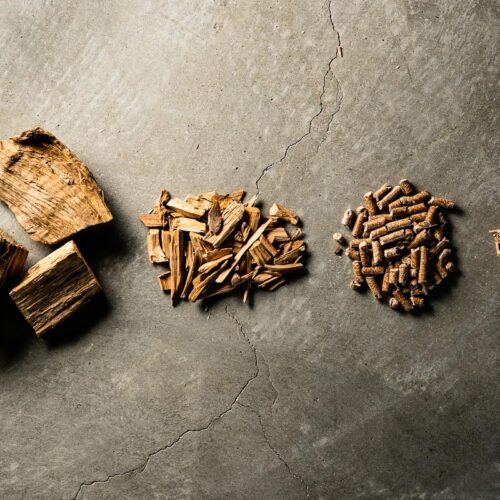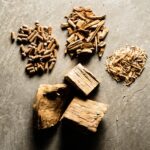Smoke gives foods a primal flavor, unmistakable on its own while enhancing other flavors. Each type of wood has different flavor qualities that it adds, allowing you to match that flavor (and the amount of it) to whatever you cook.
There is much discussion and opinion when it comes to which wood is the best for smoking a particular protein. There are some basic rules, and then there is your personal taste preferences that you will form when you experiment.
You could read entire books on the subject, and you can spend a lifetime learning the subtleties. This post will give you the guidelines to experiment.
Local Rules: Where the BBQ dish is from plays a big role in the type of wood used because of the trees that are found locally. For example, Texas uses post oak and mesquite. Carolina hickory and apple, etc. The good news is that most great smoking woods are now readily available at your local store packed and ready to use.
Fuel for the Fire. Most home smokers that aren’t pellet-fueled will use a combination of fuels. Most commonly charcoal for the heat and wood for the smoke. The charcoal will either be lump charcoal or charcoal briquettes. Those large competition trailer-type smokers will burn only wood. Learn more about the different types of BBQ smokers.
Smoke is flavor. Therefore, the wood that creates the smoke is an essential component of the finished product.
Smoke is unique in that it adds flavor to food but isn’t an actual ingredient. And it tastes so dang good! Smoke also adds color to the food, with different types of wood imparting different shades. For example, cherry will give a deep mahogany color.
Types / Species of Wood
There are dozens of different types of wood from the forest, orchards or exotic locations. These are the most popular and commonly used for smoking. Listed in order of intensity from mildest to most full-flavored.
| Wood | Flavor Intensity | Origin / Where Used | Best For |
|---|---|---|---|
| Maple | Mild | Northeast | Poultry, Pork, Vegetables |
| Alder | Mild, Sweet | Pacific Northwest | Salmon, Fish, Duck |
| Apple | Mild, Sweet, Fruity | Pacific Northwest, Midwest | Pork, Poultry, Seafood, Lamb, Vegetables |
| Cherry | Medium, Sweet, Fruity | Pacific Northwest | Pork, Poultry, Beef, Lamb |
| Oak | Medium / Full-Flavored (Different oak species have subtly different flavors.) | Texas, California, Europe, South America | Everything |
| Pecan | Strong / Full-Flavored | South | Pork, Poultry, Beef |
| Hickory | Strong / Intense | South | Beef, Pork, Poultry |
| Mesquite | Strong / Intense | Texas, South | Beef |
*Use stronger-intensity woods like mesquite and hickory in moderation so they don’t overpower the food you are smoking.
Best All-Around: If I had to choose one wood to use, it would be oak. Not sure if it’s because of its diversity, subtle but rich flavors, or that I grew up surrounded by beautiful oak trees, but I just adore the flavor and smell you get from it.
Avoid Using: Softwoods from conifer trees such as pine, cedar, fir, etc., are very resinous and will produce a bad flavor and can even be harmful.
Forms of Wood for Smoking
Wood comes in different forms for different types of smokers and uses. The smaller the form, the more quickly it starts to smoke and burn up.
| Wood Form | Smoker Type | Size |
|---|---|---|
Wood Chunks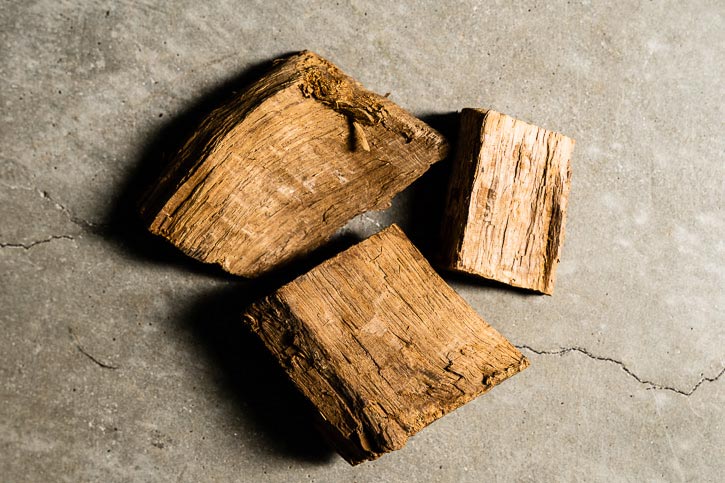 | Ceramic Kamado Smokers, Barrel Smokers, Gas Smokers | 1 1/2 to 4″ (Fist Size) |
Wood Chips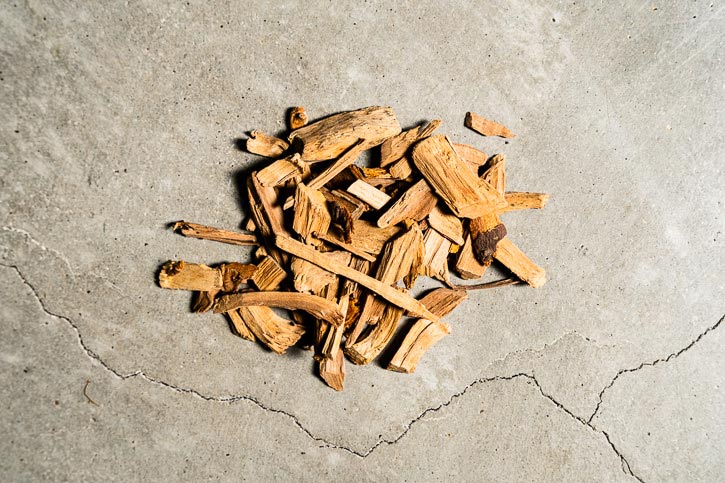 | Ceramic Kamado Smokers, Barrel Smokers, Gas Grills, Gas Smokers, Electric Smokers | 1/2 to 1″ |
Pellets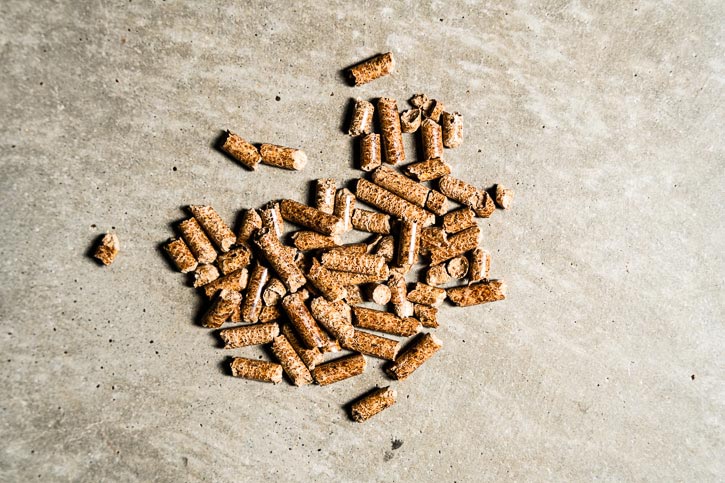 | Pellet Smokers, Pellet Smoker Tubes | Compressed Sawdust Cylinders |
Sawdust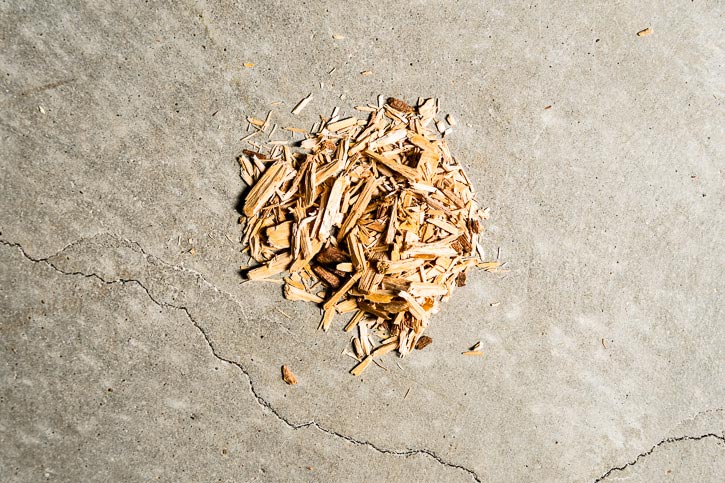 | Handheld Smokers, Some Electric Smokers | Fine to Coarsely Powdered Wood |
| Split Logs | Commercial and Large Offset Smokers | 8″ to 18″ Long |
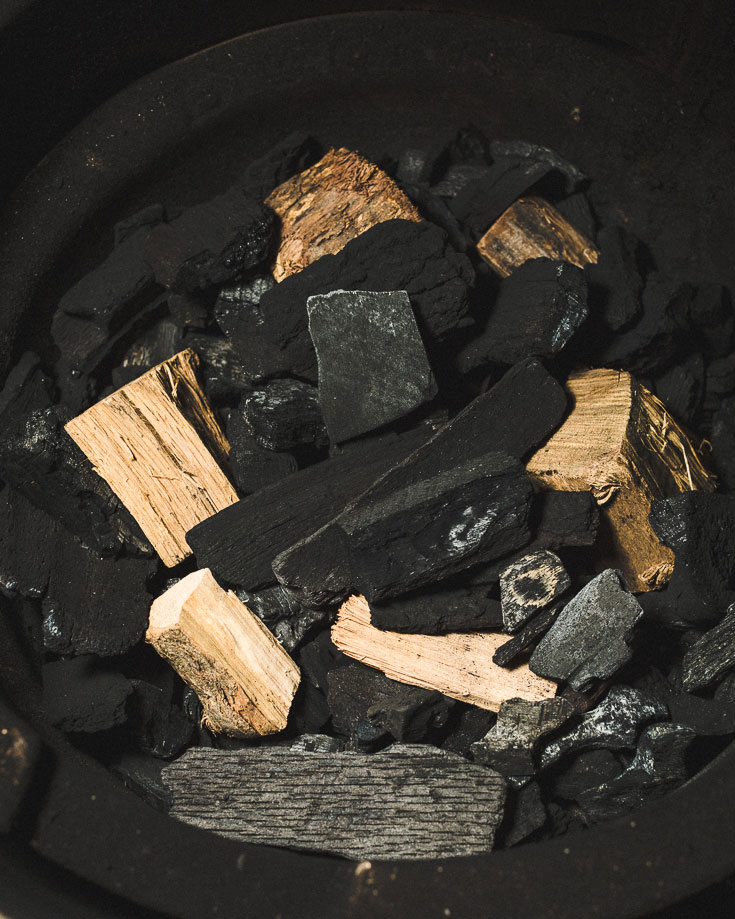
Sourcing Wood
Wood chunks, chips and pellets are available online from BBQ Guys or Amazon, at your local Ace hardware or at your local BBQ / grilling store. It’s good to find a brand you like and stick with it for consistency. Split wood is often available locally.
Pro Tips
- Mix it up! Don’t be afraid to combine different woods. Cherry is wonderful for mixing in with other woods like hickory, oak or apple. It adds a deep color to the bark on the meat.
- Smoke with dry, seasoned wood. Green wood contains a lot more moisture and the smoke will be intense and won’t produce a desirable flavor in the food.
- Store the wood off the ground and covered in a dry place away from moisture.
- If the wood looks moldy, rotten or is bug infested, don’t use it!
- If you use a pellet grill, here are 10 easy ways to get more smoke flavor out of it.
FAQs
Nope. Quickly, soaking is highly debated. Many recipes will call for you to soak the wood prior to using it. I generally do not. You can read a scientific explanation over at AmazingRibs.com.
The only time I soak wood is when I am using chips for smoking salmon and adding the chips directly to the coals.
It depends on your smoker, the temperature of the fire, how much and how long you want the smoke to deliver, and what you are cooking. Always follow the manufacturer’s instructions for how much to use.
For chunks, I will generally add 3 to 4 chunks to the charcoal.
For chips, add 2 to 3 handfuls per hour of smoke.
Pellets burn at a rate of 1/2 pound to 2 1/2 pounds of pellets per hour, depending on the temperature level set.
Mesquite is the most full-flavored wood for smoking. It is best used with beef, which can handle the intense, earthy flavor.
Matching Up Wood to Meats
Brisket: Oak + some apple and or cherry if you wish. Learn more about the best wood for smoking brisket.
Turkey: Cherry, apple, and or maple
Chicken: Hickory, maple or fruitwood (Cherry, apple, and/or pecan)
Ribs: Hickory and or cherry
Salmon: Alder
Pork: Apple, cherry, oak or pecan
Favorite Tools
- Ax/hatchet
- Metal trash cans with lid for storing wood and charcoal
- Shop vacuum for cleaning up cooled ashes
- Electric charcoal lighter
- Leather gloves for handling wood and coals

